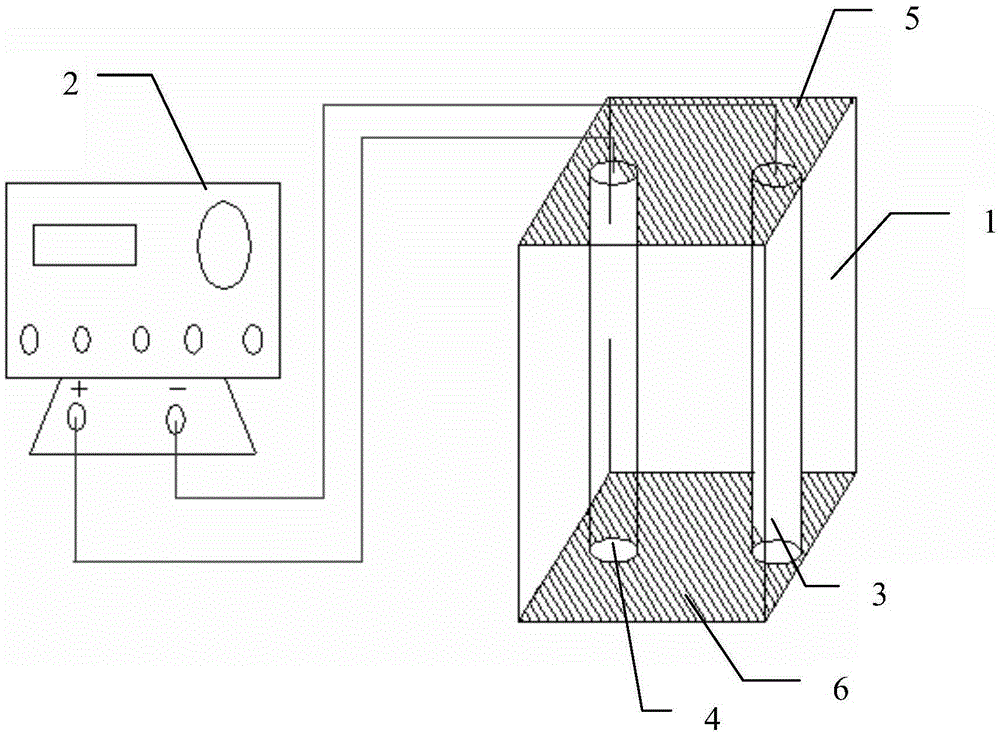A method of controlling liquid to generate Bernard convection
A liquid, one-pair technology, applied in the field of controlling liquids to produce Benard convection, can solve problems such as unsatisfactory experimental results, and achieve the effect of reducing experimental difficulty and overcoming poor reproducibility
- Summary
- Abstract
- Description
- Claims
- Application Information
AI Technical Summary
Problems solved by technology
Method used
Image
Examples
Embodiment 1
[0029] Such as figure 1 and 3 As shown, a method for controlling liquid to generate Bernard convection, comprising:
[0030] Step 1, after filtering out the solid residue in the liquid, slowly inject the liquid into the reaction vessel 1 until the liquid is full of the reaction vessel 1, ensure that there are no air bubbles in the liquid, and seal the reaction vessel 1, wherein , the reaction vessel 1 has a pair of heat-conducting surfaces 5 and 6, and the remaining surfaces are not heat-conducting. The inside of the reaction vessel 1 is provided with a positive electrode 4 and a negative electrode 3, and the positive electrode 4 and the negative electrode 3 are Electrically connected with the pulsed electric field generator 2;
[0031] Step 2, keep the output frequency value of the pulsed electric field generator 2 constant, calculate the temperature difference of a pair of heat-conducting surfaces 5 and 6 of the reaction vessel 1 according to formula (1), adjust one of the...
Embodiment 2
[0046] Such as figure 2 with 3 As shown, a method for controlling liquid to generate Bernard convection, comprising:
[0047] Step 1, after filtering out the solid residue in the liquid, slowly inject the liquid into the reaction vessel 1 until the liquid is full of the reaction vessel 1, ensure that there are no air bubbles in the liquid, and seal the reaction vessel 1, wherein , the reaction vessel 1 has a pair of heat-conducting surfaces 5 and 6, and the remaining surfaces are not heat-conducting. The inside of the reaction vessel 1 is provided with a positive electrode 4 and a negative electrode 3, and the positive electrode 4 and the negative electrode 3 are Electrically connected with the pulsed electric field generator 2;
[0048] Step 2, keep the temperature of the pair of heat conduction surfaces 5 and 6 of the reaction vessel 1 constant, and the temperature of the pair of heat conduction surfaces 5 and 6 of the reaction vessel is not equal, measure the temperature...
Embodiment 3
[0052] 1. According to the method described in Example 1, the Bernard experiment was carried out on the silicone oil and the lubricating oil, and the experimental results are shown in Tables 1-2.
[0053] Table 1 uses silicone oil to do the parameters of Bernard's experiment (constant frequency)
[0054]
[0055] Table 2 uses lubricating oil to do the parameter of Bernard experiment (frequency is constant)
[0056]
[0057] 2. According to the method described in Example 2, the Bernard experiment was carried out on the silicone oil and the lubricating oil, and the experimental results are shown in Tables 3-4.
[0058] Table 3 uses silicone oil to do the parameters of Bernard's experiment (the temperature difference is constant)
[0059]
[0060] Table 4 uses lubricating oil to do the parameters of Bernard's experiment (the temperature difference is constant)
[0061]
[0062]
[0063] 3. Controlled experiment
[0064] A routine control Bernard experiment was ...
PUM
 Login to View More
Login to View More Abstract
Description
Claims
Application Information
 Login to View More
Login to View More - R&D
- Intellectual Property
- Life Sciences
- Materials
- Tech Scout
- Unparalleled Data Quality
- Higher Quality Content
- 60% Fewer Hallucinations
Browse by: Latest US Patents, China's latest patents, Technical Efficacy Thesaurus, Application Domain, Technology Topic, Popular Technical Reports.
© 2025 PatSnap. All rights reserved.Legal|Privacy policy|Modern Slavery Act Transparency Statement|Sitemap|About US| Contact US: help@patsnap.com



